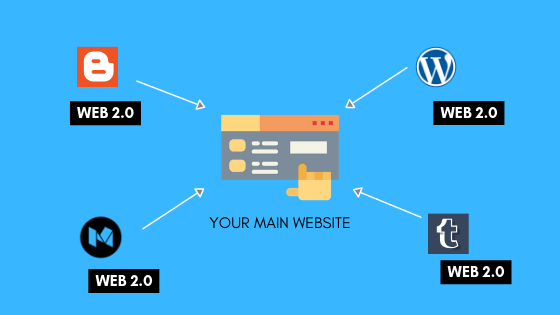In the world of search engine optimization (SEO), building quality backlinks is a crucial component of improving your website’s visibility and authority. Among the various methods for acquiring backlinks, using Web 2.0 sites is an effective and cost-efficient strategy. If you’re wondering how to use Web 2.0 sites for backlinks, you’ve come to the right place. This article will guide you through the process of leveraging these platforms to boost your SEO efforts, covering everything from choosing the right Web 2.0 sites to optimizing your backlinks for maximum effectiveness. You can view the best guide ever done on web 2.0 backlinks at the Rankers Paradise website.
What Are Web 2.0 Sites?
Web 2.0 sites refer to platforms that allow users to create and publish content without needing advanced technical skills. These platforms are characterized by their focus on user-generated content and social interaction. Popular Web 2.0 sites include platforms like WordPress.com, Blogger, Tumblr, Medium, and Wix. By creating content on these platforms, users can build backlinks to their main website, helping to increase their online presence and improve their SEO rankings.
Why Use Web 2.0 Sites for Backlinks?
Before we dive into how to use Web 2.0 sites for backlinks, it’s important to understand why they are such a valuable tool in SEO. Web 2.0 platforms offer several key benefits for backlinking:
- High Domain Authority (DA): Many Web 2.0 sites have a high DA, meaning backlinks from these sites are considered authoritative by search engines like Google.
- Do-Follow Links: A significant number of Web 2.0 sites allow users to create do-follow backlinks, which directly impact your website’s search engine rankings.
- Control Over Content: Unlike some other backlinking methods, Web 2.0 sites give you full control over the content, enabling you to place links within relevant and high-quality articles.
- Free and Easy Setup: Most Web 2.0 platforms are free to use and easy to set up, making them an accessible option for anyone looking to build backlinks without a significant investment.

How To Use Web 2.0 Sites For Backlinks: A Step-by-Step Guide
Now that we understand the importance of Web 2.0 sites for backlinks, let’s explore how to use Web 2.0 sites for backlinks in detail. Here’s a step-by-step guide to help you get started:
1. Choose the Right Web 2.0 Sites
The first step in using Web 2.0 sites for backlinks is selecting the right platforms. It’s essential to choose Web 2.0 sites that have strong authority and are well-regarded by search engines. Some of the most popular Web 2.0 sites for backlink building include:
- WordPress.com: This is one of the most powerful Web 2.0 platforms with a high DA, making it a great choice for SEO.
- Blogger: A Google-owned platform, Blogger is easy to use and integrates well with other Google services, offering an excellent opportunity for backlink building.
- Medium: This platform allows you to publish long-form content and connect with a broad audience, making it perfect for placing valuable backlinks.
- Tumblr: Known for its user-generated content, Tumblr can be a great platform for niche backlinking and reaching a younger audience.
When selecting Web 2.0 sites, choose platforms with high authority that are relevant to your niche to ensure your backlinks will provide maximum SEO benefits.
2. Create High-Quality, Relevant Content
Once you’ve chosen the Web 2.0 sites for backlinks, the next step is to create high-quality, engaging content. Search engines value original, informative, and well-written content, so it’s important to publish articles that are useful to your audience. When crafting your content, make sure to naturally integrate your target keyword, “how to use Web 2.0 sites for backlinks,” into the text.
Your content should also be relevant to your website’s niche. For example, if you run a digital marketing blog, write articles about SEO, backlinking, or digital marketing strategies. This ensures that your Web 2.0 content remains valuable to both users and search engines, increasing the chances of your backlinks being clicked and followed.
3. Place Backlinks Strategically
Now that your content is ready, the next step in how to use Web 2.0 sites for backlinks is to place your backlinks strategically. Here are some best practices to ensure your backlinks are effective:
- Contextual Placement: Instead of placing backlinks randomly, integrate them within the main body of your content where they make sense. This adds relevance to the links and improves user experience.
- Anchor Text Optimization: Use descriptive and relevant anchor text that reflects the page you are linking to. For example, if you’re linking to a page on your website that talks about SEO strategies, use anchor text like "effective SEO techniques" rather than generic text like "click here."
- Link to Inner Pages: While linking to your homepage is important, don’t forget to link to other important pages on your site. This helps spread link equity across your site, improving the SEO of multiple pages.
4. Update Your Content Regularly
To maximize the SEO benefits of how to use Web 2.0 sites for backlinks, it’s essential to update your content regularly. Search engines favor websites that publish fresh, relevant content. By consistently adding new articles and updating your existing Web 2.0 content, you can keep your backlinks active and valuable.
In addition, regularly updated content shows search engines that your Web 2.0 sites are active, which can lead to more frequent indexing and better rankings.
5. Engage with the Community
Web 2.0 sites are all about interaction and community engagement. Once your content is live, be sure to engage with other users by leaving comments, sharing their content, or linking to their articles. This not only helps build relationships within the platform but can also lead to reciprocal backlinks from other users, further boosting your SEO efforts.
You can also promote your Web 2.0 content through social media channels to drive more traffic to your page. Increased traffic and engagement signal to search engines that your content is valuable, which can help improve your rankings.
6. Track Your Results
Finally, to evaluate the effectiveness of how to use Web 2.0 sites for backlinks, it’s essential to track your results. Use SEO tools like Google Analytics, Ahrefs, or SEMrush to monitor your website’s traffic, keyword rankings, and backlink profile. By tracking your progress, you can identify which Web 2.0 sites are bringing the most value and refine your backlink strategy over time.
Best Practices for Using Web 2.0 Sites for Backlinks
To ensure the success of your backlinking strategy, keep the following best practices in mind:
- Avoid Spammy Practices: Don’t overuse backlinks or place them in irrelevant content. Spammy backlinking practices can harm your SEO rather than help it.
- Diversify Your Backlink Sources: While Web 2.0 sites are valuable, it’s important to diversify your backlink strategy by including other methods such as guest blogging, outreach, and directory submissions.
- Focus on Quality: Prioritize quality over quantity when selecting Web 2.0 platforms and creating content. A few high-quality backlinks from reputable sites will be more valuable than many low-quality links.
Conclusion
Now that you know how to use Web 2.0 sites for backlinks, it’s time to implement these strategies to improve your website’s SEO. By choosing the right Web 2.0 platforms, creating high-quality content, strategically placing backlinks, and engaging with the community, you can enhance your website’s authority and drive more traffic. Remember, consistency and quality are key in backlinking, so make sure to maintain a steady flow of valuable content to reap the long-term benefits of Web 2.0 backlinks.
By following the steps outlined in this guide, you’ll be well on your way to mastering the art of how to use Web 2.0 sites for backlinks, boosting your website’s SEO, and achieving higher rankings on search engines. Start building your backlinks today, and watch your website’s visibility grow!




